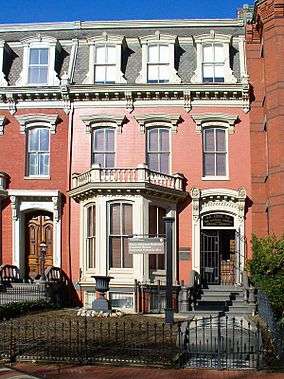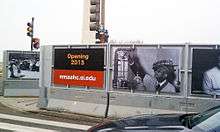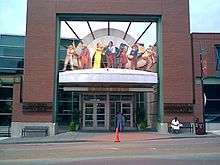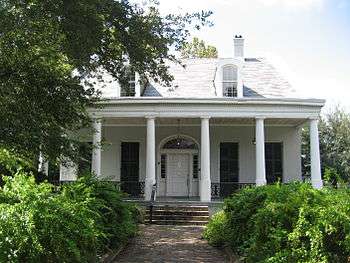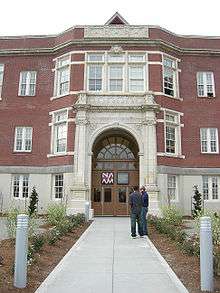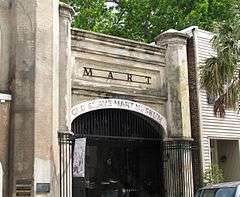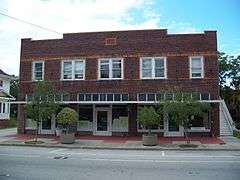List of museums focused on African Americans
This is a list of museums in the United States whose primary focus is on African American culture and history. Such museums are commonly known as African American museums. According to scholar Raymond Doswell, an African-American museum is "an institution established for the preservation of African-derived culture."[1]
Such museums have a mission of "collecting and preserving material on history and cultural heritage of African Americans." African-American museums share these goals with archives, genealogy groups, historical societies, and research libraries.[2] But museums differ as they have as a basic educational or aesthetic purpose in the collection and display of objects, and regular exhibitions for the public.[3] Being open to the public (not just researchers or by appointment) and having regular hours sets museums apart from historical sites or other facilities that may call themselves museums.[4]
History of African American museums in the United States
The first African-American museum was the College Museum in Hampton, Virginia, established in 1868.[2] Prior to 1950, there were about 30 museums devoted primarily to African-American culture and history in the United States. These were located primarily at historically black colleges and universities or at libraries that had significant African-American culture and history collections.[5]
Important collections were developed at Bennett College in Greensboro, North Carolina; Fisk University in Nashville, Tennessee; Howard University in Washington, D.C.; Lincoln University in Chester County, Pennsylvania; Morgan State University in Baltimore, Maryland; Talladega College in Talladega, Alabama; and Tuskegee University in Tuskegee, Alabama.[6] Additionally, local historical societies, history clubs, and reading groups in African-American communities also collected and displayed African-American cultural artifacts.[7]
The first independent, nonprofit museums in the United States were the African American Museum in Cleveland, Ohio (founded in 1956), the DuSable Museum of African American History in Chicago, Illinois (founded in 1960), and the International Afro American Museum in Detroit, Michigan (founded in 1965; now known as the Charles H. Wright Museum of African American History). Throughout the 1960s, the energy of the American Civil Rights Movement led to numerous local African-American museums being founded.[8] Between 1868 and 1991, there were about 150 African-American museums established in 37 states.[2]
As of 2010, the largest African-American museum in the United States was the Charles H. Wright Museum of African American History in Detroit, Michigan. It will be exceeded in size by the Smithsonian Institution's National Museum of African American History and Culture when completed in 2016.[9]
List of museums
See also
- African-American Heritage Sites
- Artworks commemorating African Americans in Washington, D.C.
- List of streets named after Martin Luther King, Jr.
References
- ↑ Doswell, Raymond. Evaluating Educational Value in Museum Exhibitions: Establishing an Evaluation Process for the Negro Leagues Baseball Museum, Kansas State University. Department of Educational Leadership, 2008, p. 8.
- 1 2 3 Dickerson, Amina J. "African American Museums and the New Century: Challenges in Leadership," In Leadership for the Future: Changing Directorial Roles in American History Museums and Historical Societies: Collected Essays. Bryant Franklin Tolles and Edward P. Alexander, ed. Nashville, Tenn.: American Association for State and Local History, 1991, p. 169.
- ↑ Burcaw, George Ellis. Introduction to Museum Work. Walnut Creek, Calif.: Altamira Press, 1997, p. 19. Quote: The American Alliance of Museums says a museum is "an organized and permanent nonprofit institution, essentially educational or aesthetic in purpose, with professional staff, which owns and utilizes tangible objects, cares for them, and exhibits them to the public on some regular schedule."
- ↑ Burcaw, p. 19.
- ↑ Coleman, Christy. "African American Museums in the Twenty-first Century," In Museum Philosophy for the Twenty-first Century. Hugh H. Genoways, ed. Lanham, Md.: Altamira Press, 2006, p. 151.
- ↑ Dickerson, p. 170.
- ↑ Coleman, p. 151-152.
- 1 2 3 Coleman, p. 152.
- ↑ Dagbovie, Pero Gaglo. African American History Reconsidered. Urbana, Ill.: University of Illinois Press, 2010, p. 75.
- ↑ Petrosino, Frankie J. "Museum and Online Registry Preserve Story of Black Railroad Porters." The Crisis. September–October 2003, p. 10.
- ↑ Evelyn, Douglas E.; Dickson, Paul; and Ackerman, S.J. On This Spot: Pinpointing the Past in Washington, D.C. Sterling, Va.: Capital Books, 2008, p. 269.
- ↑ "Watch 'Visiting with Huell Howser': 'Fire Museum'". KCET. February 20, 2008. Retrieved May 13, 2015.
- ↑ Curtis, p. 54.
- ↑ Duty, Michael W. and Penn, Elan. Dallas & Fort Worth: A Pictorial Celebration. New York: Sterling Publishing Company, 2007, p. 45.
- ↑ Mjagkij, Nina. Organizing Black America: An Encyclopedia of African American Associations. Florence, Ky.: Taylor & Francis, 2001, p. 190.
- ↑ Huntington, Tom. Ben Franklin's Philadelphia: A Guide. Mechanicsburg, Pa.: Stackpole Books, 2006, p. 73.
- ↑ Hornsby, Alton. Black America: A State-By-State Historical Encyclopedia. Santa Barbara, Calif.: ABC-CLIO, 2011, p. 275.
- ↑ Rumsey, Spencer. "Rhythm & Roots: Nassau's African American Museum Brings History to Life." Long Island Press. January 19, 2014. Accessed 2014-02-26.
- ↑ "African American Museum of the Arts." Smithsonian.com. 2011. Accessed 2012-03-02.
- ↑ Lurie, Maxine N. and Mappen, Marc. Encyclopedia of New Jersey. New Brunswick, N.J.: Rutgers University Press, 2004, p. 8.
- ↑ Faulk, Kent. "Budget Cuts Threaten Goals of Black Archives." Gadsden Times. March 4, 2002. Accessed 2013-09-07.
- ↑ Founded in 1983 by the Parker-Gray Alumni and the Alexandria Society for the Preservation of Black Heritage, the museum was originally an archive known as the Alexandria Black History Research Center. Volunteers staffed the archive. In 1987, the City of Alexandria agreed to take over the archive, expanded its mission, and turned it into the Alexandria Black History Museum. See: Pulliam, Ted. Historic Alexandria: An Illustrated History. San Antonio, Tex.: Historical Publishing Network, 2011, p. 73.
- ↑ Sisson, Richard. The American Midwest: An Interpretive Encyclopedia. Bloomington, Ind.: Indiana University Press, 2006, p. 644.
- ↑ Alexander, Edward P. The Museum in America: Innovators and Pioneers. Walnut Creek, Calif.: Alta Mira, 1997, p. 147-148.
- ↑ Faulconer, Justin (September 8, 2014). "Area around Anne Spencer House & Garden Museum added to national historic register". Lynchburg News & Advance. Retrieved August 10, 2015; Higgins, Adrian (July 29, 2014). "A Virginia Haven of the Harlem Renaissance". The Washington Post. p. C1.
- ↑ Monroe, Rachel (June 12, 2012). "Baltimore's Best Secret Museums". Baltimore Fishbowl. Retrieved May 14, 2015.
- ↑ Trotter, Joe William and Day, Jared N. Race and Renaissance: African Americans in Pittsburgh Since World War II. Pittsburgh: University of Pittsburgh Press, 2010, p. 188.
- ↑ "Visit Baton Rouge". Downtown Baton Rouge. Retrieved January 29, 2015; Davis, Kelsey (June 18, 2011). "Baton Rouge Celebrates Juneteenth". =WAFB. Retrieved January 29, 2015.
- ↑ Holland, Jesse J. Black Men Built the Capitol: Discovering African-American History In and Around Washington, D.C. Guilford, Conn.: Globe Pequot Press, 2007, p. 121.
- ↑ Dorsett, Chad (November 17, 2015). "Ribbon cutting at Bertha Lee Strickland Cultural Museum". WSNW Radio. Retrieved December 1, 2016; "Bertha Lee Strickland Cultural Museum". 2015. Retrieved December 1, 2016.
- ↑ Romano, Renee C. The Civil Rights Movement in American Memory. Athens, Ga.: University of Georgia Press, 2006, p. 28.
- ↑ Wenzel, John (November 12, 2015). "Paul Stewart, founder of Black American West Museum, dies at 89". The Denver Post. Retrieved December 6, 2015.
- ↑ McCollum, Brian. "Ex-DPS Teacher's Black History 101 Mobile Museum Carves a Niche." Detroit Free Press. February 28, 2012. Accessed 2012-03-02.
- ↑ Curtis, Nancy C. Black Heritage Sites: An African American Odyssey and Finder's Guide. Chicago: American Library Association, 1996, p. 248.
- ↑ Shuman, Robert Baird. Great American Writers, Twentieth Century. New York: Marshall Cavendish, 2002, p. 194.
- ↑ Conway, Judith. "Brown v. Board of Education": The Case for Integration. Minneapolis, Minn.: Compass Point Books, 2007, p. 80.
- ↑ "Buffalo Soldiers National Museum opens in Houston". ABC13 News. November 11, 2012. Retrieved November 14, 2015.
- ↑ Selz, Peter Howard. Art of Engagement: Visual Politics in California and Beyond. Berkeley, Calif.: University of California Press, 2006, p. 145.
- ↑ Woodford, Arthur M. This Is Detroit, 1701-2001. Detroit, Mich.: Wayne State University Press, 2001, p. 241.
- ↑ Freishtat, Sarah (July 27, 2014). "Clemson Area African American Museum looks to the future". The Independent Mail. Retrieved December 6, 2015.
- ↑ Bastien, Judy. "Celebrating Tradition." Opelousas Daily World. June 20, 2010.
- ↑ Knutson, Karen. "Arkansas Primer: It's Now on the Map, Thanks to Bill Clinton." Chicago Sun-Times. October 11, 1992.
- ↑ Marten, Charlotte. "Dorchester Had Important Role in Civil Rights History." Coastal Courier. February 3, 2012.
- ↑ Wilson, Jon. "Museum Will Open Eyes to Black History." St. Petersburg Times. March 16, 2006.
- ↑ Moker, Molly. The Official Guide to America's National Parks. New York, N.Y.: Fodors Travel, 2009, p. 106.
- ↑ Kremer, Gary R. George Washington Carver: A Biography. Santa Barbara, Calif.: Greenwood, 2011, p. 173.
- ↑ Melendez, Mel. "Carver Museum Puts Spotlight on Black History." Arizona Republic. January 27, 2006.
- ↑ Curtis, p. 274.
- ↑ The museum opened in 1983, but closed in 1985 due to space limitations. It reopened in larger quarters in 1988. Some sources use the 1988 date as the museum's founding. See: Harley-Adams, Sandra. "Baltimore's Black Wax Museum." The Crisis. February 1989, p. 12.
- ↑ Danilov, Victor J. Women and Museums: A Comprehensive Guide. Lanham, Md.: AltaMira Press, 2005, p. 238.
- ↑ Washburn, Mark (October 25, 2009). "Vivian and John Hewitt Built the Art Collection That Led to the Building of Harvey B. Gantt Center". The Charlotte Observer. p. 1A.
- ↑ Burden, Paul R. A Subject Guide to Quality Web Sites. Lanham, Md.: Scarecrow Press, 2010, p. 321.
- ↑ Wren, David (November 4, 2015). "Boeing gives $500K to Charleston's African American museum". Charleston Post and Courier. Retrieved December 6, 2015; Parker, Adam (August 21, 2015). "Museum project gets big gift in name of NAACP President Dot Scott". Charleston Post and Courier. Retrieved December 6, 2015.
- ↑ Minchin, Timothy J. and Salmond, John A. After the Dream: Black and White Southerners Since 1965. Lexington, Ky.: University Press of Kentucky, 2011, p. 259.
- ↑ Gates, Henry Louis and Higginbotham, Evelyn Brooks. Harlem Renaissance Lives From the African American National Biography. Oxford, UK: Oxford University Press, 2009, p. 246.
- ↑ Amaral, Jorge. "Making Room for History." Hartford Courant. May 20, 2005; Goode, Steven. "Grand Vision For Hartford's Northwest School." Hartford Courant. October 2, 2010.
- ↑ "Riley House Receives Collection of Abolitionist Papers." Black Issues in Higher Education. October 7, 2004, p. 13.
- ↑ "Cochran Brings Group a Message of 'Excellence'." Wichita Eagle. November 7, 1999.
- ↑ "L. E. Coleman Museum Opens This Saturday." The Gazette-Virginian. October 14, 2005.
- ↑ Bull, Roger. "Ritz Theatre Celebrates 10 Years Back in Business in LaVilla." Florida Times-Union. September 14, 2009. Accessed 2012-03-03; Potter, Dorothy Bundy Turner and Potter, Clifton W. Lynchburg, 1757-2007. Charleston, S.C.: Arcadia Publishing, 2007, p. 117.
- ↑ Brezus, Kia Shant'e. "Planting Historical Feet." Associated Press. July 16, 2000. Accessed 2012-03-03.
- ↑ White, Jacquetta (February 2, 2010). "Louisiana's African-American Heritage Trail adds seven sites, two in N.O. area". The Times-Picayune. Retrieved April 28, 2015.
- ↑ While the national historic site was designated in 1980, the museum in the visitors center was not constructed until 1996. See: Scott, David Logan and Scott, Kay Woelfel. Guide to the National Park Areas: Eastern States. Guilford, Conn.: Globe Pequot Press, 2004, p. 55; Davis, Ren and Davis, Helen. Atlanta Walks: A Comprehensive Guide to Walking, Running, and Bicycling the Area's Scenic and Historic Locales. Atlanta: Peachtree Publishers, 2011, p. 26.
- ↑ The Mary McLeod Bethune Home is operated as a historic house museum. See: Curtis, p. 61.
- ↑ Holland, p. 93.
- ↑ Johnson, Winter. "'Freedom Ride' Celebrated at Mayme A. Clayton Library and Museum." Culver City Patch. August 10, 2011. Accessed 2012-03-03.
- 1 2 Severson, Kim. "New Museums to Shine a Spotlight on Civil Rights Era." The New York Times. February 19, 2012. Accessed 2012-03-03.
- ↑ Waibel, Elizabeth. "Museum Needs Civil Rights Stories." Jackson Free Press. January 27, 2012. Accessed 2012-03-03.
- ↑ Davis, Ryan. "A Cultural Icon Rises From the Ashes in Historic Little Rock." The Crisis. Summer 2009, p. 39-40.
- ↑ "Muhammad Ali Returns Home for Center Dedication." Jet. December 12, 2005, p. 52.
- ↑ Kaufman, Polly Welts. Boston Women's Heritage Trail: Seven Self-Guided Walking Tours Through Four Centuries of Boston Women's History. Boston: Boston Women's Heritage Trail, 2006, p. 36.
- ↑ Bertho, Michelle; Crawford, Beverly; and Fogarty, Edward A. The Impact of Globalization on the United States. Westport, Conn.: Praeger, 2008, p. 46.
- ↑ Natchez museum showcases African American heritage Today in Mississippi, accessed March 2, 2016
- ↑ Ruffings, Fath Davis. "Culture Wars Won and Lost, Part II: Ethnic Museums on the Mall." Radical History Review. June 1998, p. 80.
- ↑ Lafo, Rachel Rosenfield; Capasso, Nicholas J.; and Uhrhane, Jennifer. Painting in Boston, 1950-2000. Lincoln, Mass.: DeCordova Museum and Sculpture Park, 2002, p. 36.
- ↑ "Civil Rights Museum Opens in Memphis." Jet. July 22, 1991, p. 14.
- ↑ Trescott, Jacqueline. "African American Museum Groundbreaking Showcases Living History." The Washington Post. February 22, 2012. Accessed 2012-03-03.
- ↑ The museum was originally named the Museum of African American Art, Music and Culture, but changed its name to reflect a focus solely on music. See: "Study: African American Music Museum Could Have $9.1M Annual Impact." Nashville Post. February 22, 2012. Accessed 2012-03-03; Garrison, Joy. "African-American Museum Gets New Name, Music-Only Focus." Nashville City Paper. September 1, 2011. Accessed 2012-03-03.
- ↑ "National Underground Railroad Freedom Center Opens In Cincinnati." Jet. September 13, 2004, p. 4-13.
- ↑ Some sources claim the museum did not open until 1997. The museum moved to new quarters in 1997, but opened in 1990. See: Rielly, Edward J. Baseball in the Classroom: Essays on Teaching the National Pastime. Jefferson, N.C.: McFarland & Co, 2006, p. 34; Pahigian, Josh. 101 Baseball Places to Visit Before You Strike Out. Guilford, Conn.: Lyons Press, 2008, p. 9.
- ↑ Carr, Martha. "African-American Museum Closed." Times-Picayune. November 1, 2003.
- ↑ White, Mel. Complete National Parks of the United States: Featuring 400+ Parks, Monuments, Battlefields, Historic Sites, Scenic Trails, Recreation Areas, and Seashores. Washington, D.C.: National Geographic, 2009, p. 257-258.
- ↑ McCrea, Bridget. "Museum Offers Historic Walk Through Black Culture." Black Enterprise. June 17, 2010. Accessed 2012-03-03.
- ↑ Gilmore, Susan. "African American Museum Opens to Acclaim." Seattle Times. March 9, 2008. Accessed 2008-03-09.
- ↑ American Association for State and Local History. Directory of Historical Organizations in the United States and Canada. Walnut Creek, Calif.: AltaMira Press, 2002, p. 146.
- ↑ Lynch, Christopher J. "Oran Z's Black Facts and Wax Museum: A Bizarre, Brutally-Honest African-American History Collection in Baldwin Hills." L.A. Weekly. September 8, 2011. Accessed 2012-03-03.
- ↑ Anyaso, Hilary Hurd. "African American Art Front and Center." Black Issues in Higher Education. December 2, 2004.
- ↑ Holland, p. 132.
- ↑ Anderson, Katharine. Nature, Culture, and Big Old Trees. Austin, Tex.: University of Texas Press, 2003, p. 39.
- ↑ The Old Slave Mart Museum has operated on and off since 1938, under various owners. It has, at times, been an art museum, a slave history museum, and other kinds of museum. See: Dixon, Nenie and Bull, Elias. "National Register of Historic Places Nomination Form for Old Slave Mart." February 12, 1975. Accessed 2010-05-27.
- ↑ Brown, Marquita. "Smith Robertson Museum a Cultural Experience." The Clarion-Ledger. February 6, 2011.
- ↑ McCloud, Rashad. "Black Archives Unveils New Exhibits." The Famuan. October 2, 2006. Accessed 2012-03-03.
- ↑ The Tangipahoa Black Festival began operation in 1984. It changed its name to the Tangipahoa Black Heritage Festival in 1987. It purchased property for a museum shortly thereafter, but did not become a museum until 2005. See: "About Us." Tangipahoa African American Heritage Museum and Black Veterans Archives. 2012. Accessed 2012-03-03.
- ↑ American Art Directory 2008. New Providence, N.J.: National Register Pub., 2007, p. 107.
- ↑ Harrison, Christine. "Historic Homecoming for Tuskegee Airmen as National Site Opens in Their Honor." Montgomery Advertiser. October 23, 2008.
- ↑ Dolkart, Andrew. Guide to New York City Landmarks. Hoboken, N.J.: John Wiley & Sons, 2008, p. 274.
- ↑ Thomas, Eugene (December 1, 2014). "Slavery museum at upriver plantation stirs controversy on both sides of racial divide". The Lens New Orleans. Retrieved December 6, 2015; McWhirter, Cameron (December 7, 2014). "Slavery Museum Faces Skeptics". The Wall Street Journal. Retrieved December 6, 2015.
External links
- Association of African American Museums
- "Jim Crow History" program's map and details of museums in the U.S. devoted to African American history
.jpg)
.jpg)

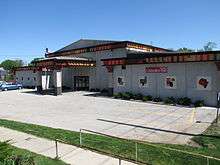






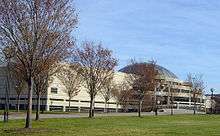


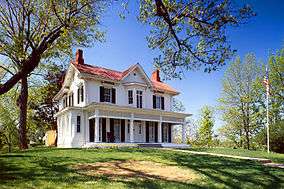

.jpg)


